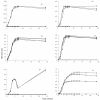N-acetyl-L-cysteine affects growth, extracellular polysaccharide production, and bacterial biofilm formation on solid surfaces
- PMID: 12902275
- PMCID: PMC169071
- DOI: 10.1128/AEM.69.8.4814-4822.2003
N-acetyl-L-cysteine affects growth, extracellular polysaccharide production, and bacterial biofilm formation on solid surfaces
Abstract
N-Acetyl-L-cysteine (NAC) is used in medical treatment of patients with chronic bronchitis. The positive effects of NAC treatment have primarily been attributed to the mucus-dissolving properties of NAC, as well as its ability to decrease biofilm formation, which reduces bacterial infections. Our results suggest that NAC also may be an interesting candidate for use as an agent to reduce and prevent biofilm formation on stainless steel surfaces in environments typical of paper mill plants. Using 10 different bacterial strains isolated from a paper mill, we found that the mode of action of NAC is chemical, as well as biological, in the case of bacterial adhesion to stainless steel surfaces. The initial adhesion of bacteria is dependent on the wettability of the substratum. NAC was shown to bind to stainless steel, increasing the wettability of the surface. Moreover, NAC decreased bacterial adhesion and even detached bacteria that were adhering to stainless steel surfaces. Growth of various bacteria, as monocultures or in a multispecies community, was inhibited at different concentrations of NAC. We also found that there was no detectable degradation of extracellular polysaccharides (EPS) by NAC, indicating that NAC reduced the production of EPS, in most bacteria tested, even at concentrations at which growth was not affected. Altogether, the presence of NAC changes the texture of the biofilm formed and makes NAC an interesting candidate for use as a general inhibitor of formation of bacterial biofilms on stainless steel surfaces.
Figures









Similar articles
-
Use of a quartz crystal microbalance to investigate the antiadhesive potential of N-acetyl-L-cysteine.Appl Environ Microbiol. 2005 May;71(5):2705-12. doi: 10.1128/AEM.71.5.2705-2712.2005. Appl Environ Microbiol. 2005. PMID: 15870362 Free PMC article.
-
Antimicrobial and Antibiofilm N-acetyl-L-cysteine Grafted Siloxane Polymers with Potential for Use in Water Systems.Int J Mol Sci. 2019 Apr 24;20(8):2011. doi: 10.3390/ijms20082011. Int J Mol Sci. 2019. PMID: 31022884 Free PMC article.
-
N-Acetyl-l-cysteine effects on multi-species oral biofilm formation and bacterial ecology.Lett Appl Microbiol. 2016 Jan;62(1):30-8. doi: 10.1111/lam.12513. Epub 2015 Dec 9. Lett Appl Microbiol. 2016. PMID: 26518358 Free PMC article.
-
The effect of N-acetylcysteine on biofilms: Implications for the treatment of respiratory tract infections.Respir Med. 2016 Aug;117:190-7. doi: 10.1016/j.rmed.2016.06.015. Epub 2016 Jun 16. Respir Med. 2016. PMID: 27492531 Review.
-
Physico-chemistry from initial bacterial adhesion to surface-programmed biofilm growth.Adv Colloid Interface Sci. 2018 Nov;261:1-14. doi: 10.1016/j.cis.2018.10.005. Epub 2018 Oct 24. Adv Colloid Interface Sci. 2018. PMID: 30376953 Review.
Cited by
-
Antibiotics-free compounds for managing carbapenem-resistant bacteria; a narrative review.Front Pharmacol. 2024 Sep 17;15:1467086. doi: 10.3389/fphar.2024.1467086. eCollection 2024. Front Pharmacol. 2024. PMID: 39355778 Free PMC article. Review.
-
In vitro Evaluation of the Antimicrobial Effect of N-acetylcysteine and Photodynamic Therapy on Root Canals Infected with Enterococcus faecalis.Iran Endod J. 2020 Fall;15(4):236-245. doi: 10.22037/iej.v15i4.26865. Iran Endod J. 2020. PMID: 36704111 Free PMC article.
-
Combined Effect of Levofloxacin and N-Acetylcysteine against Enterococcus faecalis Biofilm for Regenerative Endodontics: An in Vitro Study.Iran Endod J. 2019 Winter;14(1):40-46. doi: 10.22037/iej.v14i1.21245. Iran Endod J. 2019. PMID: 36879587 Free PMC article.
-
N-acetylcysteine inhibit biofilms produced by Pseudomonas aeruginosa.BMC Microbiol. 2010 May 12;10:140. doi: 10.1186/1471-2180-10-140. BMC Microbiol. 2010. PMID: 20462423 Free PMC article.
-
N-acetylcysteine antimicrobial action against endodontic pathogens-systematic review and meta-analysis.Odontology. 2025 Feb 2. doi: 10.1007/s10266-025-01063-y. Online ahead of print. Odontology. 2025. PMID: 39893616 Review.
References
-
- Allison, D., A. J. McBain, and P. Gilbert. 2000. Biofilms: problems of control, p. 309-327. In D. Allison, P. Gilbert, H. M. Lappin-Scott, and M. Wilson (ed.), Community structure and co-operation in biofilms, vol. 59. Cambridge University Press, Cambridge, United Kingdom.
-
- Allison, D. G., B. Ruiz, C. SanJose, A. Jaspe, and P. Gilbert. 1998. Extracellular products as mediators of the formation and detachment of Pseudomonas fluorescens biofilms. FEMS Microbiol. Lett. 167:179-184. - PubMed
-
- Blanco, M. T., J. Blanco, R. Sanchez-Benito, C. Perez-Giraldo, F. J. Moran, C. Hurtado, and A. C. Gomez-Garcia. 1997. Incubation temperatures affect adherence to plastic of Candida albicans by changing the cellular surface hydrophobicity. Microbios 89:23-28. - PubMed
-
- Bos, R., H. C. van der Mei, and H. J. Busscher. 1999. Physico-chemistry of initial microbial adhesive interactions—its mechanisms and methods for study. FEMS Microbiol. Rev. 23:179-230. - PubMed
Publication types
MeSH terms
Substances
LinkOut - more resources
Full Text Sources
Other Literature Sources

